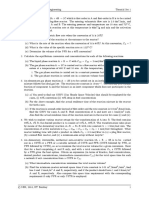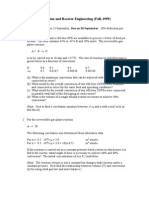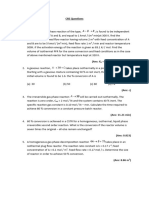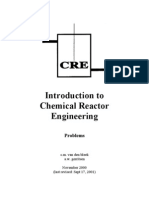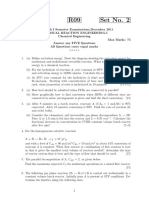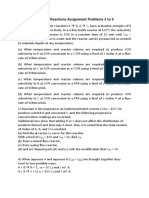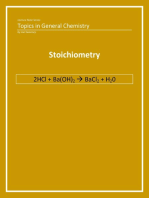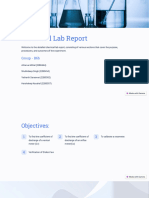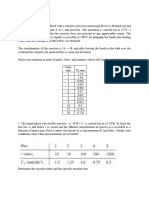Practice Problem Set 1
Practice Problem Set 1
Uploaded by
oprudra2000Copyright:
Available Formats
Practice Problem Set 1
Practice Problem Set 1
Uploaded by
oprudra2000Original Description:
Copyright
Available Formats
Share this document
Did you find this document useful?
Is this content inappropriate?
Copyright:
Available Formats
Practice Problem Set 1
Practice Problem Set 1
Uploaded by
oprudra2000Copyright:
Available Formats
CL208/324 Practice Problem Set 1
1. At present, 90% of reactant A is converted into product by a second-order reaction in a
single mixed flow reactor. We plan to place a second reactor similar to the one being used in
series with it.
(a) For the same treatment rate as that used at present, how will this addition affect the
conversion of reactant?
(b) For the same 90% conversion, by how much can the treatment rate be increased?
2. Given the following rate-concentration data for a particular gas phase reaction ( A → R)
which we plan to run in a plug flow reactor, find the space time needed for 80% conversion
of a 10 mol/lit pure A feed.
C A , mol/lit 1 2 4 6 8 10
−r A ,mol /lit ∙ min 0.01 0.02 0.04 0.09 0.16 0.25
3. Reactant A decomposes with stoichiometry A → R and with rate dependent only on CA.
The following data on this aqueous decomposition are obtained in a mixed flow reactor:
τ (sec) CAo (mol/l) CA (mol/l)
14 200 100
25 190 90
29 180 80
30 170 70
29 160 60
27 150 50
24 140 40
19 130 30
15 120 20
12 110 10
20 101 1
Determine which setup, plug flow, mixed flow, or any two-reactor combination gives
minimum τ for 90% conversion of a feed consisting of C Ao = 100 mol/l. Also find this τ
minimum. If a two-reactor scheme is found to be optimum, give C A between stages and τ for
each stage.
4. At 6500C phosphine vapour decomposes as follows
4 PH3 → P4 + 6H2, -rphosphine = (10hr-1) Cphosphine
What size of the plug flow reactor operating at 650 0C and 11.4 atm is needed for 75%
conversion of 10 mol/hr of phosphine in a 2/3 phosphine and 1/3 inert feed.
5. A reaction takes place in a closed constant volume batch reaction 3A → B (irreversible
first order gas phase). If the pressure drops to 1/3rd of its original value in 5 min, then
calculate the 1st order rate constant of this reaction.
6. Calculate the volume of CSTR and PFR in the following cases:
Volumetric feed flow rate: 4 lit/sec; Feed concentration of A: 0.002 mol/lit
Case 1: Gas phase reaction; Rate law: r = kCACB; conversion: 70%
Feed: Mole ratio (A/B) = 1:1
Reaction A + B → C + D
Case 2: Gas phase reaction; Rate law: r = kCACB2; conversion: 70%
Feed: Mole ratio (A/B) = 1:2
Reaction A + B → C + D
Case 3: Gas phase reaction; Rate law: r = kCACB2; conversion: 70%
Feed: Mole ratio (A/B) = 1:2
Reaction A + 2B → C
Case 4: Gas phase reaction; Rate law: r = kCACB2 – k’Cc ; conversion: 70%
Feed: Mole ratio (A/B) = 1:2
Reaction A + 2B ↔ C
7. The irreversible elementary reaction 2 A → B takes place in the gas phase in an isothermal
tubular plug flow reactor. Reactant A and diluent C are fed in equimolar ratio and the conversion
of A is 80%. If the molar feed rate of A is cut in half, what is the conversion of A assuming that
the feed rate of C is left unchanged? Assume ideal behaviour and that the reactor temperature
remains unchanged.
8. For a given processing rate of pure gaseous feed how many times as large must our plug flow
reactor be to raise the conversion of reactant from 1/3 to 2/3, given following kinetics?
2
a. A → R ,−r A =k C A
b. 4 A → R ,−r A=k C A
You might also like
- CRE Chap 6Document16 pagesCRE Chap 6Chrysler Kane Depnag83% (6)
- Chemical Reaction Engineering Exercise One 2022Document4 pagesChemical Reaction Engineering Exercise One 2022Matone MafologelaNo ratings yet
- Chapter 5 Octave Solutions ManualDocument34 pagesChapter 5 Octave Solutions Manualniquee9ner100% (3)
- Problem Set PLUG Flow ReactorDocument1 pageProblem Set PLUG Flow ReactorTri WidayatnoNo ratings yet
- Sol Chapter 5Document34 pagesSol Chapter 5Mae Joy PalmaNo ratings yet
- Supervisory Plan of School HeadDocument1 pageSupervisory Plan of School HeadDivine Grace Samortin95% (20)
- Timms Teaching Faculty Supervisors Evaluation FormDocument3 pagesTimms Teaching Faculty Supervisors Evaluation Formapi-271891645No ratings yet
- System of Assessment PreparationDocument3 pagesSystem of Assessment PreparationRA Orig100% (12)
- CHE3044F, 2013: Reactor Design 1: TUTORIAL 6Document4 pagesCHE3044F, 2013: Reactor Design 1: TUTORIAL 6nmhatityeNo ratings yet
- Tutorial For Chapter 23Document9 pagesTutorial For Chapter 23Thurgah VshinyNo ratings yet
- Exercise - Chemical Reaction EngineeringDocument4 pagesExercise - Chemical Reaction EngineeringJan Mark FongfarNo ratings yet
- CRE IdocxDocument8 pagesCRE IdocxParth DesaiNo ratings yet
- Tutorial QuestionsDocument8 pagesTutorial QuestionsMaame Efua Neizer100% (1)
- Assignment 2 Reactor Design Single ReactionDocument4 pagesAssignment 2 Reactor Design Single ReactionNitin MauryaNo ratings yet
- Kinetics Probset (LE4)Document4 pagesKinetics Probset (LE4)Jewls HatudNo ratings yet
- Ideal Reactors Part 2 Solved ProblemsDocument15 pagesIdeal Reactors Part 2 Solved Problemschandankumar356500000012No ratings yet
- Ideal Reactors Part 2 Solved ProblemsDocument15 pagesIdeal Reactors Part 2 Solved ProblemsWaldi SagalaNo ratings yet
- AsdfghjklDocument4 pagesAsdfghjklJV CustodioNo ratings yet
- Assignment 4Document5 pagesAssignment 4Yi Hong LowNo ratings yet
- Tut1 2016 QDocument5 pagesTut1 2016 QAbhishek SardaNo ratings yet
- Chemical Reaction Engg TutorialDocument1 pageChemical Reaction Engg TutorialShashank_PardhikarNo ratings yet
- CHAPTER 5. Solution S For CHEMICAL REACTION ENGINEERING BY-OCTAVE LVENSPIL CHAPTER 5. Downloaded FromDocument34 pagesCHAPTER 5. Solution S For CHEMICAL REACTION ENGINEERING BY-OCTAVE LVENSPIL CHAPTER 5. Downloaded FromNguyễn Hải TriềuNo ratings yet
- Assignment 1Document3 pagesAssignment 1imtiazNo ratings yet
- Tutorial 2 QuestionDocument3 pagesTutorial 2 Questionnur hidayatiNo ratings yet
- Department of Chemical Engineering, Iit Delhi Reactor Sizing Problems Assignment-2Document2 pagesDepartment of Chemical Engineering, Iit Delhi Reactor Sizing Problems Assignment-2ShubhamGuptaNo ratings yet
- Chemical Reactors - Problems of Reactor Association 47-60: (Exam Jan'09)Document6 pagesChemical Reactors - Problems of Reactor Association 47-60: (Exam Jan'09)Alfredo ZuñigaNo ratings yet
- KineticsDocument1 pageKineticsVince SantosNo ratings yet
- 3 - Prob PFR 11-12 23-35 English-1Document4 pages3 - Prob PFR 11-12 23-35 English-1Biniyam haileNo ratings yet
- Sample Exams Problems CHE 402Document3 pagesSample Exams Problems CHE 402Ricardo VelozNo ratings yet
- AssignmentDocument2 pagesAssignmentMark Lester RealNo ratings yet
- Tutorial 5drtuhDocument2 pagesTutorial 5drtuhFikrie MuhdNo ratings yet
- Chemical Reaction PDFDocument4 pagesChemical Reaction PDFonyxNo ratings yet
- CHE 502 Tutorial 5Document3 pagesCHE 502 Tutorial 5Ibnu HamidNo ratings yet
- Classroom Exercise ProblemsDocument4 pagesClassroom Exercise Problemssarahvamp14No ratings yet
- HomeworkDocument3 pagesHomeworkJudluzNo ratings yet
- CENG 211 Reaction and Reactor Engineering (Fall, 1999)Document1 pageCENG 211 Reaction and Reactor Engineering (Fall, 1999)Ricardo VelozNo ratings yet
- Revision QuestionsDocument12 pagesRevision QuestionsLiew Wen Xuan0% (2)
- Levenspiel C5 Problemas PDFDocument7 pagesLevenspiel C5 Problemas PDFbete_azmaveteNo ratings yet
- Reactor EnggDocument75 pagesReactor EnggarunperthNo ratings yet
- PFR QuestionsDocument3 pagesPFR QuestionsJitya VarshneyNo ratings yet
- Ch516 Chemical & Catalytic Reaction Engineering Assignment 5Document3 pagesCh516 Chemical & Catalytic Reaction Engineering Assignment 5Janaki Devi Parrat0% (1)
- Tutorial For Chapter 1Document3 pagesTutorial For Chapter 1Thurgah VshinyNo ratings yet
- Assignment 3Document4 pagesAssignment 3Yi Hong LowNo ratings yet
- Chemical Reaction Engineering (CHE 331A) Assignment-2 (2017-18-II)Document2 pagesChemical Reaction Engineering (CHE 331A) Assignment-2 (2017-18-II)Anonymous rkAeZVSKNo ratings yet
- Assignment VIDocument5 pagesAssignment VIprernajain.221ch039No ratings yet
- Tutorial Sheet 23.11Document2 pagesTutorial Sheet 23.11sahillone1133No ratings yet
- CRE QuestionsDocument3 pagesCRE QuestionsAnkush GuptaNo ratings yet
- CHEE 321: Chemical Reaction Engineering: Module 3: Isothermal Reactor DesignDocument16 pagesCHEE 321: Chemical Reaction Engineering: Module 3: Isothermal Reactor DesignPranav NakhateNo ratings yet
- Partial ExamDocument1 pagePartial ExamFranco CamachoNo ratings yet
- A B R KC K 0.5 Min: Tutorial 3Document2 pagesA B R KC K 0.5 Min: Tutorial 3shikharNo ratings yet
- ECH 146 Homework 1 Due Friday, 17/1/2014Document1 pageECH 146 Homework 1 Due Friday, 17/1/2014Tiệp MatícNo ratings yet
- BE-Chemical A Semester) III Yr - December 2019 U CV (-: Thapar Institute of Engineering and Technology PatialaDocument2 pagesBE-Chemical A Semester) III Yr - December 2019 U CV (-: Thapar Institute of Engineering and Technology PatialaSHOURYA SINGHNo ratings yet
- Introduction To Chemical Reactor Engineering - Problems PDFDocument75 pagesIntroduction To Chemical Reactor Engineering - Problems PDFJojie-Ann Alabarca100% (1)
- R09 Set No. 2Document8 pagesR09 Set No. 2Shakoor MalikNo ratings yet
- Chapter 5 - ExerciseDocument11 pagesChapter 5 - ExerciseTruong NguyenNo ratings yet
- Assignment OneDocument2 pagesAssignment OneAbdi Bekele WakoNo ratings yet
- Microsoft Word - 6 - Prob RTD-Non Id React 11-12 61-78 - EnglishDocument9 pagesMicrosoft Word - 6 - Prob RTD-Non Id React 11-12 61-78 - EnglishPavithra Sivaraja100% (1)
- Week 2Document37 pagesWeek 2HAJEYYNo ratings yet
- Multiple Reactions Assignment Problems 2 To 5Document2 pagesMultiple Reactions Assignment Problems 2 To 5DechenPemaNo ratings yet
- A Modern Course in Statistical PhysicsFrom EverandA Modern Course in Statistical PhysicsRating: 3.5 out of 5 stars3.5/5 (2)
- Analysis and Design of Multicell DC/DC Converters Using Vectorized ModelsFrom EverandAnalysis and Design of Multicell DC/DC Converters Using Vectorized ModelsNo ratings yet
- Reviews in Computational Chemistry, Volume 31From EverandReviews in Computational Chemistry, Volume 31Abby L. ParrillNo ratings yet
- CL242 Slides 14 Free ConvectionDocument24 pagesCL242 Slides 14 Free Convectionoprudra2000No ratings yet
- CL242 Slides 12 Forced Convection InternalDocument26 pagesCL242 Slides 12 Forced Convection Internaloprudra2000No ratings yet
- CL242 Slides 7 Radiation FluxDocument29 pagesCL242 Slides 7 Radiation Fluxoprudra2000No ratings yet
- 001 Mid Sem Exam Time Table Feb 2024Document1 page001 Mid Sem Exam Time Table Feb 2024oprudra2000No ratings yet
- Chemical Lab ReportDocument17 pagesChemical Lab Reportoprudra2000No ratings yet
- QN 1 TutDocument9 pagesQN 1 Tutoprudra2000No ratings yet
- Practice Problem Set - 3Document2 pagesPractice Problem Set - 3oprudra2000No ratings yet
- NGA Health InsuranceDocument1 pageNGA Health Insuranceoprudra2000No ratings yet
- Lesson Plan 4 Lipski Social StudiesDocument6 pagesLesson Plan 4 Lipski Social Studiesapi-409912459No ratings yet
- TitleDocument2 pagesTitledaniel holmesNo ratings yet
- 3rd Year PromotionDocument3 pages3rd Year PromotionRose Ann VillanuevaNo ratings yet
- 2016 Teens 1 Specifications: o LIVE BEAT 1 Units 1 To 9 (Student's Book & Workbook)Document1 page2016 Teens 1 Specifications: o LIVE BEAT 1 Units 1 To 9 (Student's Book & Workbook)Cami De La CanalNo ratings yet
- Innovation Resources: Promoting, Managing, and Sustaining Innovation. New York: Free PressDocument2 pagesInnovation Resources: Promoting, Managing, and Sustaining Innovation. New York: Free PressVictorAugustoM.RiosNo ratings yet
- Learning Plan: College of EducationDocument4 pagesLearning Plan: College of EducationMikho HarleyNo ratings yet
- Eastern Michigan University Academic Transcript: Institution Credit Transcript Totals Courses in ProgressDocument5 pagesEastern Michigan University Academic Transcript: Institution Credit Transcript Totals Courses in Progressapi-375038446No ratings yet
- Raft Professional DevelopmentDocument13 pagesRaft Professional Developmentapi-399750986No ratings yet
- Appreciative Inquiry - An OverviewDocument2 pagesAppreciative Inquiry - An OverviewDr. Sarah Elaine Eaton100% (2)
- General Chemistry 2: 2 Semester - Module 7Document16 pagesGeneral Chemistry 2: 2 Semester - Module 7Juan JohnNo ratings yet
- CS CallflowsDocument20 pagesCS CallflowsMenow ShutterNo ratings yet
- Vector Mechanics For Engineers: Dynamics: Kinematics of ParticlesDocument99 pagesVector Mechanics For Engineers: Dynamics: Kinematics of ParticlesMike Raphy T. VerdonNo ratings yet
- Forces Motion VocabDocument15 pagesForces Motion VocabEDWARD TORRES-BALDERASNo ratings yet
- Man NatureDocument13 pagesMan Natureapi-356614816No ratings yet
- DPP 1-13 Rotation JA Nurture LiveDocument118 pagesDPP 1-13 Rotation JA Nurture LivebqfhwdmdcyNo ratings yet
- Aly's FriendDocument1 pageAly's Friendbe hatem100% (1)
- Resume John BunkerDocument8 pagesResume John BunkerJohn BunkerNo ratings yet
- LAC REFLECTION JOURNAL - AshguifilesDocument3 pagesLAC REFLECTION JOURNAL - AshguifilesJessa Beth Rimando100% (5)
- Behavioral Theory in Teaching: Rochelle D. Tan SdoqcDocument9 pagesBehavioral Theory in Teaching: Rochelle D. Tan SdoqcRochelle TanNo ratings yet
- Dynamic Communicative Language Teaching Lesson Plan Ideas That Will Keep Your Students TalkingDocument4 pagesDynamic Communicative Language Teaching Lesson Plan Ideas That Will Keep Your Students TalkingveritoNo ratings yet
- Transcript For ProposalDocument1 pageTranscript For ProposalJoesamay CaingalNo ratings yet
- Understanding Motion: Reference Point and Reference FrameDocument17 pagesUnderstanding Motion: Reference Point and Reference FrameAadilNo ratings yet
- Score Participation Skill/Technique Assessment Cooperation/Attitude/Sportsmanship ScoreDocument2 pagesScore Participation Skill/Technique Assessment Cooperation/Attitude/Sportsmanship Scorerom keroNo ratings yet
- Aacomplishment FEBRUARY 2019Document3 pagesAacomplishment FEBRUARY 2019Aldrin PaguiriganNo ratings yet
- Chapter 3 Chemical KineticsDocument46 pagesChapter 3 Chemical KineticsaadarshceoNo ratings yet
- Exercise 1Document2 pagesExercise 1api-19796687No ratings yet
- Bài tập đọc hiểu dưới sự trợ giúp của AIDocument3 pagesBài tập đọc hiểu dưới sự trợ giúp của AIHào LêNo ratings yet



















